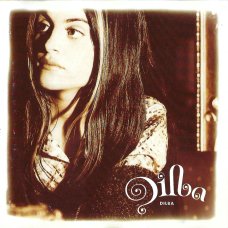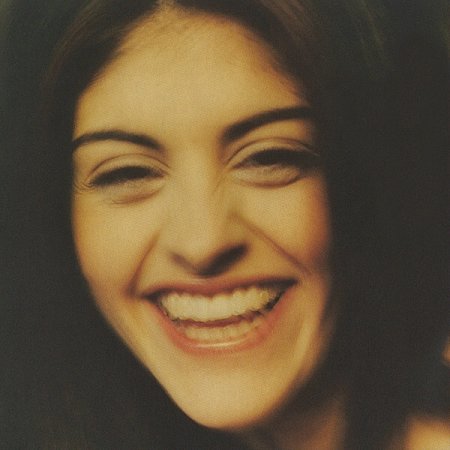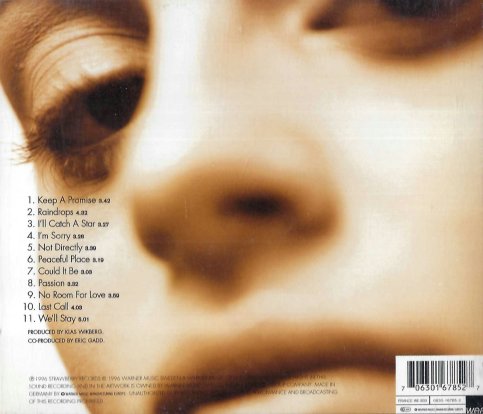 Monica Kristina Ingeborg Törnell, born 3 June 1954 in Trönö Parish, Hälsingland (Gävleborg County), is a Swedish singer and songwriter.
Monica Kristina Ingeborg Törnell, born 3 June 1954 in Trönö Parish, Hälsingland (Gävleborg County), is a Swedish singer and songwriter.
After being discovered by Cornelis Vreeswijk in 1971, she was for two decades a prominent singer in several genres, mainly show tunes and rock. Together with Lasse Holm, she sang Sweden’s entry in the Eurovision Song Contest in Bergen, Norway in 1986. In 2017, she released Understanding Eye, her first album in 25 years.
She is the mother of Tobias (born 1973) and Mattias Törnell (born 1980).

Big Mama is a 1986 music album by Swedish singer Monica Törnell. The disc is dedicated to Tobias and Mattias (her children).
The recording was produced and arranged by Janne Schaffer for Earmeal Production AB and Monica Törnell for Mica Production except Ensam med dig vid ett fönsterbord produced by Thomas Folland and Monica Törnell and Vem tänder alla ljusen produced by Anders and Hans Nordmark. Engineered by Leif Allansson in Sonet Studio 3 except Vem tänder alla ljusen recorded by Anders and Hans Nordmark in J.A.M. Recording Studios, London, Ensam med dig vid ett fönsterbord recorded by Erik Olhester and Leif Allansson, Sista steget kvar recorded by Leif Allansson and Jan Ugand in Sonet Studio 1 and 3 and Atlantis. The disc number is Air Music AIRLP 1019. Also released as a music print Air Music AIR 979 (1986).

The album features British singer Steve Marriott (known from the groups Small Faces and Humble Pie) as a guest artist. Big Mama was his name for Törnell, which gave the album its name. In the same year (1986), the single Mellan roderna (Kom till mig)/Du måste så för att få skörd (AIRS 035) was released. (wikipedia)

This is an interesting pop album … Monica Törnell has a great voice, but the album – typical for the 80s – is unfortunately overproduced … that’s a particular shame with the song ‘’I Just Want to Make Love to You” (featuring Steve Marriott on vocals !).

Personnel:
Sam Bengtsson (bass)
Hector Bingert (saxophone)
Thomas Folland (guitar, slide guitar)
Henrik “Hempo” Hildén (drums)
Erik Häusler (saxophone)
Henrik Janson (guitar, background vocals)
Mats Karlsson (synthesizer)
Per Lindvall (drums)
Peter Ljung (synthesizer)
Björn J:son Lindh (flute)
Kettil Medelius (piano)
Anders Nordmark (synthesizer)
Hans Nordmark (synthesizer)
Hasse Olsson (organ)
Magnus Persson (drums,
Svante Persson (piano, synthesizer)
Janne Schaffer (guitar, guitar synthesizer)
Chris Taylor (drums)
Bror Törnell (guitar)
Monica Törnell (vocals)
Christian Veltman (bass)
Clarence Öfwerman (organ, synthesizer)
+
background vocals:
Matts Alsberg – Micke Andersson – Douglas E. Lawton – Kay Söderström
+
Steve Marriott (vocals on 03.)

Tracklist:
01. Ett liv (som du, som jag…) (Wikström) 4.18
02. Du bara leker med mig (Kellgren/Flink) 5.46
03. I Just Want to Make Love to You (dedicated to Alex Harvey) (Dixon) 4.59
04. Mellan raderna (kom till mig) (Gessle) 3.49
05. Sista steget kvar (Beyond The Rain) (Jenkins/ClarkGessle) 4.21
06. Drömmar (Wickman) 5.05
07. Andens hus (Schaffer/M.Törnell) 4.20
08. Vem tänder alla ljusen (H.Nordmark/A.Nordmark) 4.33
09. Du måste så för att få skörd (You Have To Hurt) (King/Musker/Rönnblom/M.Törnell) 4.58
10. Ensam med dig vid ett fönsterbord (de Wolfe/Hansson) 4.25

* (coming soon)
**
In 1986 Steve Marriott & Packet Of Three had two gigs in Uddevalla Sweden, afterwards there was a party for Steve and the band.
At this gig and party Steve met the Swedish singer Monica Törnell,later on in Stockholm they sang a duet on her record Big Mama.
When she met Steve,she was so excited,that she hugged him and lifted him up in the air and Steve said Big Mama.
She found this very funny and named the album Big Mama. (Rebecca-Dandelion Zilliacus )
The now deleted official website:


 Dilbahar Demirbağ (born 24 November 1971), known as Dilba, is a Swedish pop singer of Kurdish background. Her first album Dilba (1996) reached commercial success.
Dilbahar Demirbağ (born 24 November 1971), known as Dilba, is a Swedish pop singer of Kurdish background. Her first album Dilba (1996) reached commercial success.







 Now I want to be modern again
Now I want to be modern again The songs are not only energetic and danceable but also explicitly political. In her lyrics, the queer artist* stages a world in which socially made norms are broken and set anew. “We need new norms” is what LIN demands in the opener “Queer Lover” – right away with the album’s first breaths and thus sets the framework for the following 31 minutes.
The songs are not only energetic and danceable but also explicitly political. In her lyrics, the queer artist* stages a world in which socially made norms are broken and set anew. “We need new norms” is what LIN demands in the opener “Queer Lover” – right away with the album’s first breaths and thus sets the framework for the following 31 minutes.
 With “Ablution” LIN opens the picture level of “Gradient” – a song like a film, it could hardly be more impressive. No wonder that there is also an impressive video here, for which no more and no less than the fight against and the smashing and overcoming of the patriarchy was choreographically staged.
With “Ablution” LIN opens the picture level of “Gradient” – a song like a film, it could hardly be more impressive. No wonder that there is also an impressive video here, for which no more and no less than the fight against and the smashing and overcoming of the patriarchy was choreographically staged.





 Molly Lilly Maria Nilsson (born 14 December 1984) is a Swedish singer-songwriter and musician. She is the owner of an independent record label, Dark Skies Association, founded in 2009. As of 2004, Nilsson resides in Berlin.
Molly Lilly Maria Nilsson (born 14 December 1984) is a Swedish singer-songwriter and musician. She is the owner of an independent record label, Dark Skies Association, founded in 2009. As of 2004, Nilsson resides in Berlin.










 Jane Mallory Birkin OBE (14 December 1946 – 16 July 2023) was a British and French actress and singer. She had a decade-long musical and romantic partnership with Serge Gainsbourg. She also had a prolific career as an actress, mostly in French cinema.
Jane Mallory Birkin OBE (14 December 1946 – 16 July 2023) was a British and French actress and singer. She had a decade-long musical and romantic partnership with Serge Gainsbourg. She also had a prolific career as an actress, mostly in French cinema.











 Barbara Joan “Barbra” Streisand (/ˈstraɪsænd/ STRY-sand; born April 24, 1942) is an American singer, actress, songwriter, film and television producer, and director. With a career spanning over six decades, she has achieved success in multiple fields of entertainment and is among the few performers awarded an Emmy, Grammy, Oscar, and Tony (EGOT).
Barbara Joan “Barbra” Streisand (/ˈstraɪsænd/ STRY-sand; born April 24, 1942) is an American singer, actress, songwriter, film and television producer, and director. With a career spanning over six decades, she has achieved success in multiple fields of entertainment and is among the few performers awarded an Emmy, Grammy, Oscar, and Tony (EGOT).









 Nits (known until 1989 as The Nits) are a Dutch pop group founded in 1974. Their musical style has varied considerably over the years, as has their line-up with the core of Henk Hofstede (the group’s lead singer and lyricist), Rob Kloet, drummer, and Robert Jan Stips (Supersister, Gruppo Sportivo, Golden Earring), keyboards.
Nits (known until 1989 as The Nits) are a Dutch pop group founded in 1974. Their musical style has varied considerably over the years, as has their line-up with the core of Henk Hofstede (the group’s lead singer and lyricist), Rob Kloet, drummer, and Robert Jan Stips (Supersister, Gruppo Sportivo, Golden Earring), keyboards.









 Mary Isobel Catherine Bernadette O’Brien (16 April 1939 – 2 March 1999), better known by her stage name Dusty Springfield, was an English singer. With her distinctive mezzo-soprano sound, she was a popular singer of blue-eyed soul, pop and dramatic ballads, with French chanson, country, and jazz in her repertoire. During her 1960s peak, she ranked among the most successful British female performers on both sides of the Atlantic. Her image – marked by a peroxide blonde bouffant/beehive hairstyle, heavy makeup (thick black eyeliner and eye shadow) and evening gowns, as well as stylised, gestural performances – made her an icon of the Swinging Sixties.
Mary Isobel Catherine Bernadette O’Brien (16 April 1939 – 2 March 1999), better known by her stage name Dusty Springfield, was an English singer. With her distinctive mezzo-soprano sound, she was a popular singer of blue-eyed soul, pop and dramatic ballads, with French chanson, country, and jazz in her repertoire. During her 1960s peak, she ranked among the most successful British female performers on both sides of the Atlantic. Her image – marked by a peroxide blonde bouffant/beehive hairstyle, heavy makeup (thick black eyeliner and eye shadow) and evening gowns, as well as stylised, gestural performances – made her an icon of the Swinging Sixties. at home. In 1958, she joined her first professional group, The Lana Sisters. Two years later, with her brother Tom Springfield and Tim Feild, Springfield formed the folk-pop vocal trio The Springfields. Two of their five 1961–63 Top 40 UK hits – “Island of Dreams” and “Say I Won’t Be There” – reached no. 5 in the charts, both in the spring of 1963. In 1962 they also hit big in the United States with their cover of “Silver Threads and Golden Needles”.
at home. In 1958, she joined her first professional group, The Lana Sisters. Two years later, with her brother Tom Springfield and Tim Feild, Springfield formed the folk-pop vocal trio The Springfields. Two of their five 1961–63 Top 40 UK hits – “Island of Dreams” and “Say I Won’t Be There” – reached no. 5 in the charts, both in the spring of 1963. In 1962 they also hit big in the United States with their cover of “Silver Threads and Golden Needles”.








 A fan website:
A fan website:

 María de Montserrat Bibiana Concepción Caballé i Folch or Folc (12 April 1933 – 6 October 2018), known simply as Montserrat Caballé (i Folch), was a Spanish operatic soprano from Catalonia. Widely considered to be one of the best sopranos of the 20th century, she won a variety of musical awards thoroughout her six-decade career, including three Grammy Awards.
María de Montserrat Bibiana Concepción Caballé i Folch or Folc (12 April 1933 – 6 October 2018), known simply as Montserrat Caballé (i Folch), was a Spanish operatic soprano from Catalonia. Widely considered to be one of the best sopranos of the 20th century, she won a variety of musical awards thoroughout her six-decade career, including three Grammy Awards.







 Not only for the music of the Sixties were there many low budget samplers, the same is true for the musicians of the Seventies.
Not only for the music of the Sixties were there many low budget samplers, the same is true for the musicians of the Seventies.


